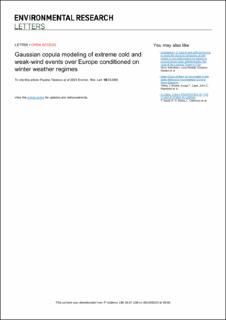| dc.contributor.author | Tedesco, Paulina Souza | |
| dc.contributor.author | Lenkoski, Frank Alexander | |
| dc.contributor.author | Bloomfield, Hannah C. | |
| dc.contributor.author | Sillmann, Jana | |
| dc.date.accessioned | 2023-10-06T08:47:37Z | |
| dc.date.available | 2023-10-06T08:47:37Z | |
| dc.date.created | 2023-05-04T10:42:24Z | |
| dc.date.issued | 2023 | |
| dc.identifier.citation | Environmental Research Letters. 2023, 18 (3), . | en_US |
| dc.identifier.issn | 1748-9326 | |
| dc.identifier.uri | https://hdl.handle.net/11250/3094754 | |
| dc.description.abstract | A transition to renewable energy is needed to mitigate climate change. In Europe, this transition has been led by wind energy, which is one of the fastest growing energy sources. However, energy demand and production are sensitive to meteorological conditions and atmospheric variability at multiple time scales. To accomplish the required balance between these two variables, critical conditions of high demand and low wind energy supply must be considered in the design of energy systems. We describe a methodology for modeling joint distributions of meteorological variables without making any assumptions about their marginal distributions. In this context, Gaussian copulas are used to model the correlated nature of cold and weak-wind events. The marginal distributions are modeled with logistic regressions defining two sets of binary variables as predictors: four large-scale weather regimes (WRs) and the months of the extended winter season. By applying this framework to ERA5 data, we can compute the joint probabilities of co-occurrence of cold and weak-wind events on a high-resolution grid (0.2◦).Our results show that (a) WRs must be considered when modeling cold and weak-wind events, (b) it is essential to account for the correlations between these events when modeling their joint distribution, (c) we need to analyze each month separately, and (d) the highest estimated number of days with compound events are associated with the negative phase of the North Atlantic Oscillation (3 days on average over Finland, Ireland, and Lithuania in January, and France and Luxembourg in February) and the Scandinavian blocking pattern (3 days on average over Ireland in January and Denmark in February). This information could be relevant for application in sub-seasonal to seasonal forecasts of such events | en_US |
| dc.language.iso | eng | en_US |
| dc.rights | Navngivelse 4.0 Internasjonal | * |
| dc.rights.uri | http://creativecommons.org/licenses/by/4.0/deed.no | * |
| dc.subject | Copula models | en_US |
| dc.subject | Copula modeller | en_US |
| dc.subject | Gaussian copula | en_US |
| dc.subject | Weather regimes | en_US |
| dc.subject | Værregimer | en_US |
| dc.subject | Renewable energy | en_US |
| dc.subject | Fornybar energi | en_US |
| dc.subject | Wind power | en_US |
| dc.subject | Vindkraft | en_US |
| dc.subject | Subseasonal variability | en_US |
| dc.title | Gaussian copula modeling of extreme cold and weak-wind events over Europe conditioned on winter weather regimes | en_US |
| dc.title.alternative | Gaussian copula modeling of extreme cold and weak-wind events over Europe conditioned on winter weather regimes | en_US |
| dc.type | Peer reviewed | en_US |
| dc.type | Journal article | en_US |
| dc.description.version | publishedVersion | en_US |
| cristin.ispublished | true | |
| cristin.fulltext | original | |
| cristin.qualitycode | 2 | |
| dc.identifier.doi | 10.1088/1748-9326/acb6aa | |
| dc.identifier.cristin | 2145373 | |
| dc.source.journal | Environmental Research Letters | en_US |
| dc.source.volume | 18 | en_US |
| dc.source.issue | 3 | en_US |
| dc.source.pagenumber | 10 | en_US |
| dc.relation.project | Norges forskningsråd: 303411 | en_US |
| dc.relation.project | Norges forskningsråd: 309562 | en_US |
| dc.subject.nsi | VDP::Matematikk og Naturvitenskap: 400 | en_US |
| dc.subject.nsi | VDP::Matematikk og Naturvitenskap: 400::Geofag: 450::Meteorologi: 453 | en_US |
| dc.subject.nsi | VDP::Matematikk og Naturvitenskap: 400::Matematikk: 410::Statistikk: 412 | en_US |

